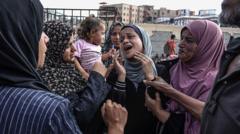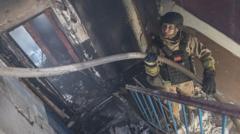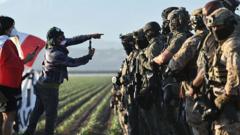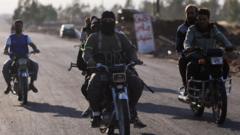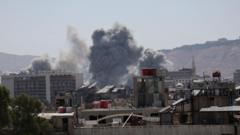The Nasser Medical Complex in southern Gaza has reported that Israeli military actions resulted in the deaths of at least 32 individuals, further intensifying humanitarian concerns in the region.
Gaza Conflict Escalates: At Least 32 Killed Near Aid Distribution Site, Report Claim

Gaza Conflict Escalates: At Least 32 Killed Near Aid Distribution Site, Report Claim
Recent violence in Gaza sees escalating casualties as airstrikes reportedly target food distribution locations, compounding humanitarian crises.
The health authorities in Gaza confirmed the casualties following what was described as gunfire from Israeli troops near a distribution site managed by an Israel-backed organization. Reports emerged late Saturday morning stating that many victims were brought to the Nasser Medical Complex, although details surrounding the circumstances of the deaths remain unclear.
The ongoing violence remains linked to a controversial new food distribution system initiated by Israeli authorities nearly two months ago. This change has replaced the previous U.N.-supervised system to curb Hamas's alleged misappropriation of humanitarian aid. Since its rollout, the United Nations indicated over 670 deaths among Palestinians near these designated aid points.
The Gaza Humanitarian Foundation, tasked by Israel to manage food aid, maintains that the new framework was developed to prevent hoarding and illicit sales by Hamas. However, critics assert that the system has converted the pursuit of food into perilous encounters, as large crowds gather near distribution sites, often leading to clashes that result in high civilian casualties.
Incidents of Israeli troops firing at individuals approaching the aid points have occurred regularly, ostensibly as a measure to maintain order amidst desperate populations. Despite this, Israeli officials have accused aid organizations of exaggerating casualty figures while continuing to attribute disturbances to Hamas interference.
Challenging conditions persist as widespread hunger lingers in Gaza, exacerbated by an extensive blockade that lasted 80 days. Alarming reports from UNRWA revealed increased malnutrition among children, indicating severe food insecurity.
This latest incident underscores the dire humanitarian challenges faced in Gaza and calls into question the effectiveness of the new food distribution model amid rising violence.
Ameera Harouda contributed to this report. Patrick Kingsley is leading coverage of the ongoing conflict from the region.
The ongoing violence remains linked to a controversial new food distribution system initiated by Israeli authorities nearly two months ago. This change has replaced the previous U.N.-supervised system to curb Hamas's alleged misappropriation of humanitarian aid. Since its rollout, the United Nations indicated over 670 deaths among Palestinians near these designated aid points.
The Gaza Humanitarian Foundation, tasked by Israel to manage food aid, maintains that the new framework was developed to prevent hoarding and illicit sales by Hamas. However, critics assert that the system has converted the pursuit of food into perilous encounters, as large crowds gather near distribution sites, often leading to clashes that result in high civilian casualties.
Incidents of Israeli troops firing at individuals approaching the aid points have occurred regularly, ostensibly as a measure to maintain order amidst desperate populations. Despite this, Israeli officials have accused aid organizations of exaggerating casualty figures while continuing to attribute disturbances to Hamas interference.
Challenging conditions persist as widespread hunger lingers in Gaza, exacerbated by an extensive blockade that lasted 80 days. Alarming reports from UNRWA revealed increased malnutrition among children, indicating severe food insecurity.
This latest incident underscores the dire humanitarian challenges faced in Gaza and calls into question the effectiveness of the new food distribution model amid rising violence.
Ameera Harouda contributed to this report. Patrick Kingsley is leading coverage of the ongoing conflict from the region.

